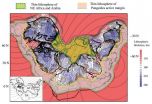Authors Dan McKenzie, Michael C. Daly, and Keith Priestley wondered what the pattern of plate thickness looked like before Pangea broke up -- so they reconstructed Pangea using Rayleigh wave tomography and plate tectonics, taking the plate thickness with the continents as they moved them.
To their surprise, the thick parts of the plates all came together to form a boomerang-shaped arc. The outside of the boomerang consists of a subduction zone where oceanic plates were returned to the mantle. The inside of the boomerang consists of plate with a thickness of about 100 km, which was strongly deformed and heated about 600 million years ago. Pangea itself was assembled from a number of different plates. The continental deformation that took place during this assembly must have been controlled by the plate thickness, since it produced a continuous boomerang shaped region of thick plate.
FEATURED ARTICLE
The lithospheric structure of Pangea
Dan McKenzie et al., Bullard Labs, University of Cambridge, Cambridge, UK. Published online ahead of print on 17 July 2015; http://dx.doi.org/10.1130/G36819.1.
Other recently posted GEOLOGY articles (see below) cover such topics as Gold and copper deposits in eastern Australia; The first high-resolution southern European diatom record alongside existing pollen and oxygen isotope data from Lake Ioannina sediment core I-284 (northwest Greece); Findings that the volcanic winter and "genetic bottleneck" hypotheses are unsupported by the continuous paleoecological record of the Toba eruption interval in Africa; and A study of core material from the slip zone related to the 2011 Tohoku, Japan, earthquake.
Porphyry Au-Cu mineralization controlled by reactivation of an arc-transverse volcanosedimentary subbasin
Nathan Fox et al., Centre of Excellence in Ore Deposits (CODES), University of Tasmania, Hobart, Australia. Published online ahead of print on 28 July 2015; http://dx.doi.org/10.1130/G36992.1.
Many of the world's largest repositories of gold and copper occur in porphyry deposits, which are commonly located in volcanic arcs (e.g., western North and South America, Indonesia). Rapid rates of tectonic uplift and erosion in these environments mean that porphyry deposits are usually only preserved in ancient rocks under exceptional circumstances. This paper by Nathan Fox and colleagues describes Cadia East, one of the world's largest porphyry gold and copper deposits, which is located in a 450-million-year-old volcanic arc in eastern Australia. By reconstructing the way that this deposit was formed and importantly, preserved, this work has implications for future discoveries of gold and copper resources in both modern and ancient volcanic arc environments.
Reconciling diverse lacustrine and terrestrial system response to penultimate deglacial warming in southern Europe
Graham P. Wilson et al., Dept. of Geography and International Development, University of Chester, UK. Published online ahead of print on 28 July 2015; http://dx.doi.org/10.1130/G36807.1.
During the penultimate deglaciation (about 129,000 to 136,000 years ago) global climate shifted from one of the most extreme glaciations to one of the warmest interglacials, yet the regional expression of climate changes during this transition remains understudied. Wilson, Reed, Frogley, Hughes and Tzedakis present the first high-resolution southern European diatom record alongside existing pollen and oxygen isotope data, from Lake Ioannina sediment core I-284 (northwest Greece), to assess the character and timing of terrestrial and aquatic ecosystem response to rapid climate warming. Their study finds a complex deglaciation, and provides firm evidence for changes in lake conditions and regional forest populations in response to abrupt changes in North Atlantic conditions associated with Heinrich Stadial 11. This study also finds marked diachroneity in lake and terrestrial ecosystem response to warming at the onset of the last interglacial. Snowmelt and glacial meltwater transfer are identified as primary driving mechanisms for an abrupt increase in lake level 2.7 thousand years ago, prior to regional forest expansion and associated peak precipitation. This finding has wider implications in demonstrating that, under certain boundary conditions, lakes in mountainous karstic environments are highly sensitive to past climate warming because of the role of local glaciers in controlling regional groundwater levels.
High-resolution paleoecological records from Lake Malawi show no significant cooling associated with the Mount Toba supereruption at ca. 75 ka
Lily J. Jackson et al., University of Texas, Austin, Texas, USA. Published online ahead of print on 28 July 2015; http://dx.doi.org/10.1130/G36917.1.
A detailed high-resolution study of the paleoecology of sediments from Lake Malawi, East Africa, finds no evidence to support the hypothesis of significant cooling in this region of Africa as a result of the Mount Toba volcanic super-eruption about 75 thousand years ago. This eruption, the largest documented for the last two million years, has been previously hypothesized to have caused a dramatic decline in early modern Homo sapiens population size and genetic diversity, making it a potentially critical event in human evolution. This study presents the first paleoecological evidence from East Africa of environmental conditions in the few hundred years before, during and after the eruption with a temporal resolution of less than a decade per sampling interval. If a global cooling event associated with the Toba eruption caused the African tropics (where early humans certainly lived at the time) to cool by several degrees Celsius, the result would have been a major change in the circulation of deep tropical lakes of the region, which in turn would be heralded by a major change in the lake's ecology. These changes would be evident from fossils of algae and animals living in the lake that are highly sensitive to such changes. Authors Lily Jackson and colleagues find no evidence of such changes following the Toba volcanic ash horizon that is preserved in the sediments. Thus, both the volcanic winter and "genetic bottleneck" hypotheses are unsupported by this first continuous paleoecological record of the Toba eruption interval in Africa.
The geological CO2 degassing history of a long-lived caldera
Giovanni Chiodini et al., Istituto Nazionale di Geofisica e Vulcanologia, Sezione di Bologna, Bologna, Italy. Published online ahead of print on 17 July 2015; http://dx.doi.org/10.1130/G36905.1.
Calderas have caused the majority of volcanic catastrophes documented on Earth. A crucial way to predict future behavior of a caldera is to reconstruct its past and present-day CO2 degassing record. Here, Giovanni Chiodini and colleagues use abundance and isotopic signature of calcites in hydrothermal reservoir rocks to reconstruct, for the first time, the long-term CO2 degassing regime of the high-risk Campi Flegrei caldera. Their original isotopic and petrological results demonstrate that a sizeable magmatic CO2 flux has persisted throughout the entire (40,000 years) Campi Flegrei geological history, supporting the existence of large (>1000 to 2000 cubic kilometers) feeding parental magma reservoir. The authors also propose that, during heating episodes of a hydrothermal system, part of the past deposited calcite can become reconverted into CO2, sustaining the surface gas output. They conclude that the actual magmatic CO2 degassing flux from calderas may be severely underestimated if subsurface calcite precipitation is not taken into account.
Integrating field observations and fracture mechanics models to constrain seismic source parameters for ancient earthquakes
W. Ashley Griffith, University of Texas at Arlington, Arlington, Texas, USA; and Vikas Prakash, Case Western Reserve University, Cleveland, Ohio, USA. Published online ahead of print on 17 July 2015; http://dx.doi.org/10.1130/G36773.1.
Most of our understanding of earthquakes comes from interpretation of strong ground motion seismograms recorded at great distances from the hypocenter; however, near-source stress and particle motion fields are difficult to resolve by such indirect observations. Exhumed fault zones (faults brought to Earth's surface by uplift and erosion) offer insights into coseismic fault processes with unparalleled spatial resolution. The duration of coseismic deformation is typically in the range milliseconds to seconds; unfortunately such transient deformation on exhumed faults occurred millions of years ago, so the tradeoff in gaining great spatial resolution is the loss of temporal resolution. In this study we investigate the formation of fractures filled with pseudotachylyte, a rock formed by frictional heat on sliding faults, to constrain properties of the source time function of ancient earthquakes. These cracks help us mitigate our loss of temporal resolution because their formation can be uniquely tied to the transient stress fields associated with earthquake ruptures. Earlier studies showed that the orientation of these cracks informs us about the directivity and rupture velocity of ancient earthquakes. Here we show that the crack length helps us characterize the earthquake rise time, slip rate, stress drop, fracture energy, and slip-weakening behavior.
Linking hematite (U-Th)/He dating with the microtextural record of seismicity in the Wasatch fault damage zone, Utah, USA
Alexis K. Ault et al., Utah State University, Logan, Utah, USA. Published online ahead of print on 17 July 2015; http://dx.doi.org/10.1130/G36897.1.
Geochronologic methods to directly date past fault slip events are few, limiting the ability to interpret the rock record of seismicity. Hematite is common in fault zones, amenable to (U-Th)/He dating, and may be thermally reset by shear heating events and/or recrystallization. Here we present microtextural observations and hematite (U-Th)/He dates from glossy, iridescent, hematite-coated small fault surfaces in the Wasatch fault zone, Utah (USA). Hematite cataclasis, local fault surface iridescence and hematite recrystallization, and associated Pliocene hematite (U-Th)/He dates capture a partial record of Wasatch damage zone fault activity in a restricted depth range. Internally reproducible but significantly different hematite (U-Th)/He dates from multiple discrete locations on a single fault surface are hypothesized to record rapid cooling from flash heating at surface asperities during seismic slip events, possibly as aftershocks after a major earthquake. This work reveals an intriguing connection between fault damage zone seismicity and its preserved lithologic and geochronologic record.
Determining vorticity axes from grain-scale dispersion of crystallographic orientations
Zachary D. Michels et al., University of Wisconsin, Madison, Wisconsin, USA. Published online ahead of print on 17 July 2015; http://dx.doi.org/10.1130/G36868.1.
Strain modeling and observations of geologic shear zones indicate that solid-state fabric elements (i.e., lineation, foliation) do not always track the deformation geometry of a shear zone and, therefore, are not always reliable for determining the direction of shear. We present a new method for constraining the kinematic reference frame that does not require contextual information about the fabric orientation. This method leverages rotational statistics to calculate the position of vorticity axes from populations of grain-scale crystallographic orientation data. The position of the bulk vorticity axis identifies the rotational axis of the simple shear component of deformation, and thereby constrains the configuration of the strain geometry and the kinematic reference frame. We present the results of our crystallographic vorticity analysis (CVA) applied to three different geological shear zones. In each case, the position of the calculated bulk vorticity axis matches the position of the vorticity vector inferred from previous studies in the same shear zones. This new method allows the position of vorticity axes to be evaluated independently of foliation and lineation information, and without assumptions about the kinematics of deformation.
Response of natural smectite to seismogenic heating and potential implications for the 2011 Tohoku earthquake in the Japan Trench
A.M. Schleicher et al., Helmholtz Zentrum Potsdam, Deutsches GeoForschungsZentrum GFZ, Telegrafenberg, 14473 Potsdam, Germany. Published online ahead of print on 28 July 2015; http://dx.doi.org/10.1130/G36846.1.
In March 2011, a large earthquake of magnitude 9.0 caused large slip (50 m) on the shallow portion of the fault zone in the Japan Trench, initiating a disastrous tsunami. About one year later, JFAST (Japan Trench Fast Drilling Project) Expedition 343 retrieved about 55 meters of core material from this fault zone. The most abundant clay mineral retrieved in these cores is pelagic-sourced smectite. Schleicher and colleagues studied the potential of the mineral to preserve a record for coseismic heating associated with the earthquake by laboratory examination of mineral hydration and dehydration during brief and protracted heating. They found that smectite recovers more quickly to its original hydration state after brief heating than protracted heating. In both sets of experiments, smectite structure recovery is 100% to 125 degrees Celsius, but only partly recovery occurs at higher temperatures, until non-recoverable collapse of smectite at higher than 200 degrees Celsius, regardless of the heating duration. This places a firm upper bound on the local temperature conditions. Thus, based on the behavior of smectitic clay in samples from JFAST core, we conclude that the slip zone investigated did not undergo distributed frictional heating over 200 degrees Celsius.
Mesoproterozoic Tasmania: Witness to the East Antarctica - Laurentia connection within Nuna
Jacob A. Mulder et al., ARC Centre of Excellence in Ore Deposits (CODES), University of Tasmania, Australia. Published online ahead of print on 28 July 2015; http://dx.doi.org/10.1130/G36850.1.
Most recent paleogeographic reconstructions of one of Earth's oldest supercontinents, Nuna, juxtapose North American, Australia, and East Antarctica, although the relative positioning of these landmasses differs considerably between models. Clues into the configuration of continents within Nuna can be gained from identifying the source regions of sedimentary basins that formed during the extension and break up of Nuna approximately 1.4 billion years ago. This study by Mulder et al. focuses on identifying the source region(s) of sediments deposited in one such basin, the Rocky Cape Group of Tasmania (southeast Australia), by comparing the age and chemistry of detrital zircons from the Rocky Cape Group to a compilation of age and chemical data from zircons derived from rocks in North America, Australia, and East Antarctica. Surprisingly, the detrital zircons in the Rocky Cape Group are unlikely to have been sourced from any geological terrane currently exposed in Australia. Instead, the zircons from the Rocky Cape Group appear to have been sourced from rocks exposed in southwest North America and currently concealed beneath ice cover in East Antarctica. In addition to clarifying the position of Tasmania within Nuna, this study provides compelling evidence for a close connection between East Antarctica and southwestern North America within Nuna.
Transport-controlled hydrothermal replacement of calcite by Mg-carbonates
Laura Jonas et al., Institut für Geologie, Mineralogie und Geophysik, Ruhr-Universität Bochum, Bochum, Germany. Published online ahead of print on 28 July 2015; http://dx.doi.org/10.1130/G36934.1.
The Mg-bearing carbonate mineral dolomite [CaMg(CO3)2] is an important reservoir rock for oil and gas. The formation of dolomite is generally considered to take place by the replacement of calcite, a pure Ca-carbonate (CaCO3) precursor. Laura Jonas and colleagues conducted a series of hydrothermal experiments to study the rates and mechanisms that control Mg-carbonate formation by the replacement of CaCO3 in which a single crystal of calcite (CaCO3) reacted with a Mg-rich solution. The reaction leads to the dissolution of calcite followed by immediate precipitation of Mg-carbonate on the surface of the initial calcite forming a porous, double-layered reaction rim of magnesite (MgCO3) and dolomite. Both reaction layers exhibit a remarkable compositional gradient indicating chemical variations in the pore fluid across the reaction rim. This observation suggests that the element transport governing the exchange of aqueous Mg and Ca through the inter-connected pore network of the reaction rim controls both the rate of the overall replacement process and the chemical composition of the reaction rim on a microscopic scale.
Temporal evolution of mantle wedge oxygen fugacity during subduction initiation
Maryjo Brounce et al., University of Rhode Island, Narragansett Bay Campus, Narragansett, Rhode Island, USA. Published online ahead of print on 28 July 2015; http://dx.doi.org/10.1130/G36742.1.
Chemically, Earth's rocky interior is more reducing than its oxidized exterior. The ocean floor spends upwards of tens of million years exposed to the oxygen-rich oceans at Earth's surface, becoming oxidized itself, before it is recycled back into the deep Earth. We have studied the rocks that record the creation and evolution of the volcanic islands in the western Pacific Ocean to test whether recycling the oxidized ocean floor oxidizes Earth's interior, and if so, how quickly this occurs. We find that Earth's interior can become oxidized quickly -- within fewer than 4 million years -- under this recycling influence. This result suggests that the lavas erupting near the onset of subduction can release oxidized volcanic gases such as carbon dioxide and sulfur dioxide, to the atmosphere and oceans. Plate tectonics, therefore, must impact the generation and maintenance of the oxidized surface of our pleasantly habitable planet.
Enhanced microbial activity in carbon-rich pillow lavas, Ordovician Great Britain and Ireland
John Parnell et al., University of Aberdeen, Aberdeen, UK. Published online ahead of print on 28 July 2015; http://dx.doi.org/10.1130/G36937.1.
Cores through the ocean floor show evidence of microbial activity in volcanic rocks, including pillow lavas. Several studies show that this microbial colonization of seafloor volcanic rocks is also evident in the geological record. This study by John Parnell and colleagues examines pillow lavas of Ordovician age (~450 million years old) in Britain and Ireland and finds that microbial activity was greater in lavas that had incorporated carbon from sedimentary layers when they formed. The enhanced activity was measured using the sulfur isotope composition of pyrite (iron sulfide) precipitated by sulfate-reducing microbes. The deep oceans in Ordovician time had less oxygen than today, which allowed more carbon to be preserved, so this colonization of seafloor rocks may have been more widespread at that time.
Asynchrony in key Holocene chronologies: Evidence from Irish bog pines
Max C.A. Torbenson et al., University of Arkansas, Fayetteville, Arkansas, USA. Published online ahead of print on 28 July 2015; http://dx.doi.org/10.1130/G36914.1.
Paleoclimate proxy records are an important tool in understanding the dynamics and long-term trends of Earth's climate. The radiocarbon calibration curve (IntCal), based on annually dated tree-ring records, and the Greenland Ice Core Chronology 2005 (GICC05) are the most widely used timescales for the dating of Holocene (the most recent ~12,000 years) proxy records, and their synchronization is critical when contrasting records from different contexts. In this study, Torbenson and colleagues compare a tree-ring-derived date for an unprecedented phase of pine recruitment on Irish bogs, attributed to an extreme climatic event about 8,200 year ago, with the GICC05 date for this event in Greenland ice cores. The lack of overlap in dates suggests that there is an offset between the two chronologies, with GICC05 being older than the tree rings, and therefore IntCal, by up to 60-70 years for the early Holocene. The discrepancy in dates could have implications for previous interpretations on how past climatic episodes evolved over time and space.
Intermediate-depth earthquake generation and shear zone formation caused by grain size reduction and shear heating
M. Thielmann et al., Institut für Geophysik, ETH Zürich, Zurich, Switzerland. Published online ahead of print on 28 July 2015; http://dx.doi.org/10.1130/G36864.1.
The causes for earthquakes between 50 and 300 km depth are enigmatic, since rocks cannot simply break at those depths due to the confining pressure. Thermal runaway is a mechanism that could result in earthquake-like failure without actually breaking the rock. Ductile deformation results in heating, which in turn results in weakening of the rock. However, researchers have found that the stresses needed for this mechanism are really large (and therefore very hard to reach). In their study, M. Thielmann and colleagues use numerical models to combine the heating mechanism with another weakening mechanism, namely grain size reduction. They find that this second mechanism aids thermal weakening and significantly reduces the stress necessary for thermal runaway (in particular when we consider a rock which is made up of more than one mineral), which in turn makes it more likely that this mechanism is indeed the cause for intermediate-depth earthquakes.
Persistent oceanic anoxia and elevated extinction rates separate the Cambrian and Ordovician radiations
Matthew R. Saltzman et al., The Ohio State University, Columbus, Ohio, USA. Published online ahead of print on 28 July 2015; http://dx.doi.org/10.1130/G36814.1.
Recurrent mass extinction events (at "biomere" -- a biostratigraphic unit -- boundaries) characterize the middle Cambrian to Early Ordovician (Tremadocian) time interval that is between the major Cambrian and Ordovician radiations of animal life. A role for anoxia in maintaining elevated extinction rates in the late Cambrian has been proposed based on coincidence of an extinction with positive excursions in delta-13Ccarb and delta-34SCAS (CAS = carbonate-associated sulfate). Here, Matthew Saltzman and colleagues examine an Early Ordovician extinction event at the base of the North American Stairsian Stage (upper Tremadocian), and demonstrate concurrent onset of positive excursions in delta-13C and delta-34S inferred to reflect enhanced organic matter burial under anoxic waters. Sea-level rise may have brought anoxic waters onto the shelf to initiate extinctions. The evidence for delta-13C excursions and elevated extinction rates appears to wane in the Tremadocian, consistent with progressive oxygenation of the oceans reaching a threshold that helped facilitate initial stages of the Great Ordovician Biodiversification Event.
INFORMATION:
GEOLOGY articles published online ahead of print can be accessed online at http://geology.gsapubs.org/content/early/recent. All abstracts are open-access at http://geology.gsapubs.org/; representatives of the media may obtain complimentary articles by contacting Kea Giles at the address above.
Please discuss articles of interest with the authors before publishing stories on their work, and please make reference to GEOLOGY in articles published. Contact Kea Giles for additional information or assistance.
Non-media requests for articles may be directed to GSA Sales and Service, gsaservice@geosociety.org.




